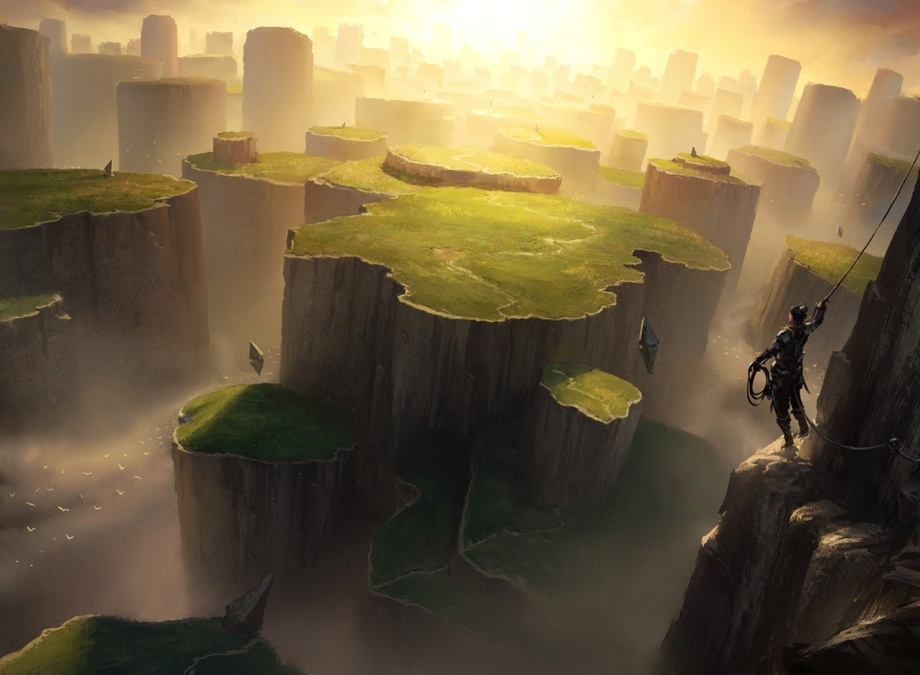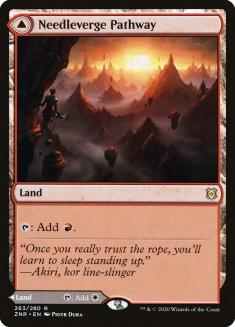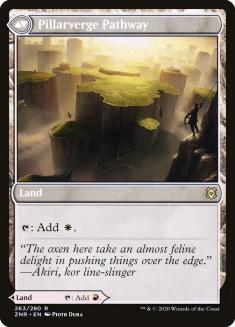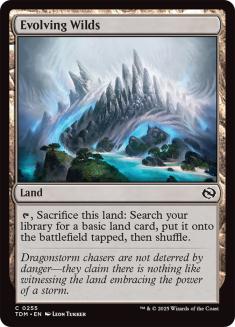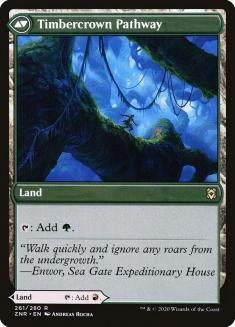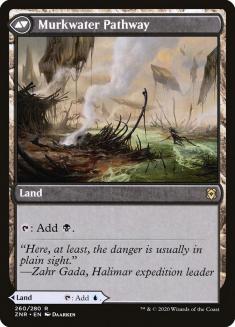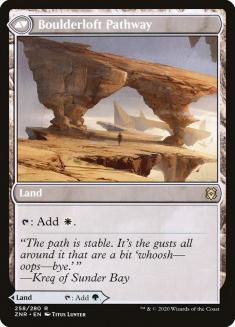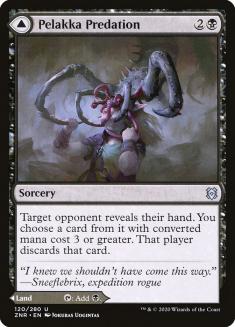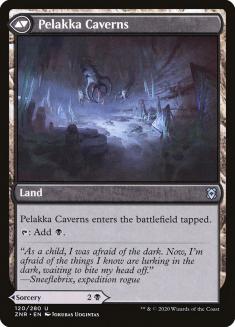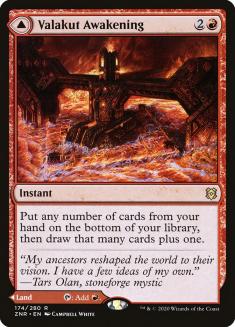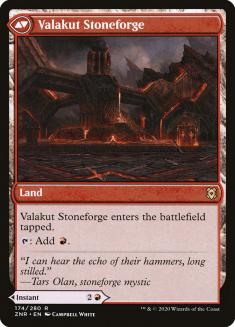It seems like only yesterday (okay, it was literally yesterday) I was writing that I wanted to see two-color lands that were balanced in some way other than entering the battlefield tapped. That’s some nice turnaround, now isn’t it?
I suppose we should have known that there’d be some kind of cycle of two-color lands that could enter the battlefield untapped to replace the shocklands rotating out of Standard, but I’m happy that this is the solution.
The last time double-faced cards were previewed was Ixalan and I was immensely excited. I love a flavor home run, and cards that gave you a quest to discover uncharted territory to turn into a land were absolutely perfect. Now the mechanic comes back in a different form in Zendikar Rising. I can’t say I’m as excited, because these cards do nothing for me as far as their flavor goes. These are crunchy, rules-heavy cards with game play utility. But what they lack in flavor, they definitely carry in that utility.
Double-faced lands are exactly what I want fetchlands to be. They don’t waste time, they don’t abuse the graveyard, and they do exactly what they say. Obviously, the fact that they aren’t secretly five-color lands means they don’t do the same heavy lifting in casual and eternal formats that fetchlands do, but I think they’re much healthier for balanced competitive play.
As far as I’m concerned, these lands are basically perfect. They don’t favor aggressive decks the way lands that cost life do, and they don’t favor control decks the way that tapped lands (especially Temples) do. They allow playing more than one color in a way that functions smoothly, but they still make you pay attention to the colored requirements of your spells. I really like that Lavaglide Pathway makes it harder to play cards like Goblin Chainwhirler in an Izzet deck than other two-color lands would. This captures a lot of the interesting strategic decisions offered by fetchlands without the power level issue.
In general, I get that rare two-color lands sell packs, and I wouldn’t expect the strongest two-color lands to come at a different rarity, but in this case, I am a little sad that these can’t be common because I think they play so well they’d be great for Limited, although Zendikar Rising wouldn’t exactly be the best set to print very strong two-color lands at common, since it’s not really a multicolor set (historically it’s more likely to favor monocolor strategies).
As for Limited, I suppose Zendikar Rising probably wants a common land that interacts well with landfall, so I assume we’ll just see Evolving Wilds again, and maybe that’s for the best.
While this “cycle” just replaces shocklands in Standard, it’s more interesting in Pioneer and Historic, where untapped two-color lands are in high demand. In Pioneer, there’s notably more support for fast mana in enemy-color pairs than ally-color pairs.
There are three of each of these in Zendikar Rising, so from a Pioneer perspective Timbercrown Pathway, Murkwater Pathway, and Boulderloft Pathway are considerably more exciting than the others (for those trying to follow along, that’s Gruul, Dimir, and Boros receiving additional support in that format). Given that this will be another cycle of ten lands, it won’t even the disparity between enemy and allied pairs, but the more tools there are, the less important that is, so this is still a great step toward opening that format up.
Ultimately, while I’m excited about the introduction of this new kind of two-color land, there’s not that much to say about a two-color land cycle that’s great because it does exactly what it says.
More interesting are the land/spell split cards. For those of us who have been wondering about whether we’d see a return to a Standard format where 24-25 lands was the standard after rotation, the answer seems to be a pretty clear no at this point. Without knowing exactly what kinds of spells will come attached to lands, it’s theoretically possible that these won’t see much play, or that, if the spells are particularly bad, they’ll see play, but that they’ll be played “as lands” because you’ll want to use the land side most of the time, but I don’t expect that.
“As lands,” these cards are horrible. A land that enters the battlefield tapped and taps for a single color of mana is really bad compared to other lands, so these just won’t see play if we expect to play them as lands 90% of the time. Valakut Awakening is pretty similar to a spell with mountaincycling 1, except that you don’t need another land to be able to cycle it, but you also don’t get a basic land at the end (the point is that cycling 1 costs the same amount of mana that entering the battlefield tapped costs).
Ultimately, I think these won’t see that much play unless the spell side is pretty good or we have a deck that’s particularly tolerant of a land that enters the battlefield tapped, like a monocolor deck with a relatively high curve and high land count that’s looking for a bit more utility/consistency.
Take Valakut Awakening as an example. I don’t think you’d want to play this in a deck with three or more colors ever, since you’ll want more fixing from your lands and the spell isn’t strong enough on its own, and you also don’t want it in a typical aggro deck, where the spell and land are both too inefficient, but it could be strong in a more midrange Big Red/Chonky Red strategy where your higher curve and land count make it more likely that you can find a turn where you can play a tapped land without missing a play, and your games might go long enough that Valakut Awakening can pull you back into a game where you’d been flooding or drawing the wrong half of your deck.
Ultimately, I hope and expect that Valakut Awakening is one of the less impressive of these kinds of cards. So far, we know about it and Pelakka Predation. Pelakka Predation is awkward, since we tend to think of both lands and discard spells as cards that are strong early and weak late. There are some times and matchups where Pelakka Predation would be a great option, but again, I don’t think the power level on this card is especially high.
More interestingly, we’ve seen a rare and an uncommon with the same pattern, which makes me think we’ll have at least ten land/spell DFCs in the set, so we’ll have a lot of options when we’re choosing which of these cards, if any, we want to play, and a lot of chances that one of them is very strong.
I like that these cards raise really interesting questions about how many lands you want to play. Ultimately, I don’t think there’s a clear answer to how much you should count these as a land compared to counting them as a spell when building your deck. I think it’s going to depend on what portion of the time you expect to use each side of the card, but I don’t think it’s exactly as simple as “I’m going to play this as a spell 60% of the time, so I’m going to count this as 40% of a land,” because playing enough lands is often more about avoiding a failure state where you can’t cast spells, and this can be played as a land 40% of the time that you need it to.
If recent Standard has shown us anything, it’s that playing with a really high land count is nice. Between that and the fact that these are such weak lands, I think I’ll generally try to treat these almost exactly as spells when I’m building my deck, but even that’s confused. We’re going to Zendikar Rising with landfall, the block that originally brought us 26-land low-curve aggro decks, and we’re coming off of a Standard format where seemingly any deck might have 28 lands. “Playing this as a spell” doesn’t mean much without a target number of spells/lands in mind, so what am I really saying?
I guess I’m saying that I expect that I won’t generally play DFCs unless my deck already has around 24 other lands. A tapped land that taps for a single color is such a bad land to play that I want to make sure I can hit my land drops most of the time with better lands, and since I think these cards will be best in decks with higher curves and land counts, that means I’ll want more traditional lands before I start playing these. If I have fewer than 24 other lands, I’d rather just play a Castle or something where I would be playing this; then, if I have to play it because I don’t have another land, it’ll still potentially offer utility later.
Double-faced lands are exactly what I want fetchlands to be. They don’t waste time, they don’t abuse the graveyard, and they do exactly what they say.
On the other hand, if I’m playing a deck that doesn’t want to miss any land drops because it has a lot of landfall or some very expensive cards or whatever it may be, if I already have 24-26 lands, I might prefer to replace some of the additional lands with lands that can be cast as spells even if those spells aren’t very good, because sometimes I’ll just draw more lands than I can reasonably get onto the battlefield and I need to have some way to get rid of extras, so these are best as flood insurance for high-land decks.
All in all, I don’t think the modal double-faced cards we’ve seen are much to get excited about, but context is everything, and in a set where we might want to play “too many” lands just to have lands to play, modal double-faced lands are a fantastic way to artificially increase your land count without taking on too much risk.

